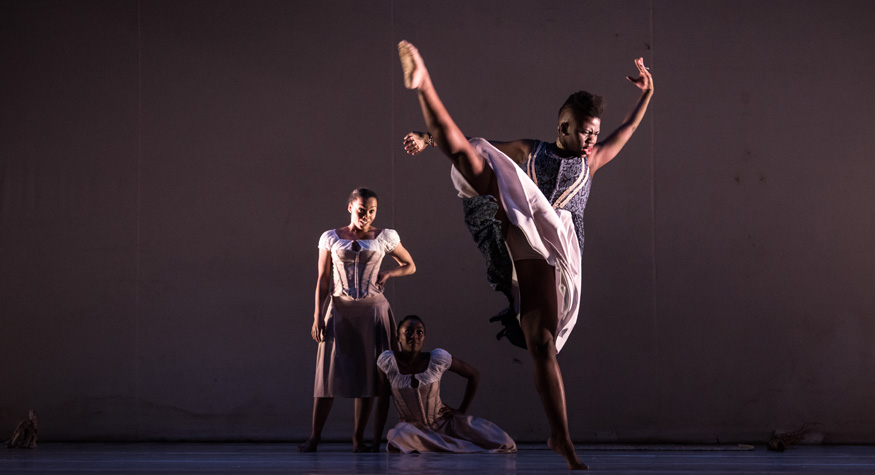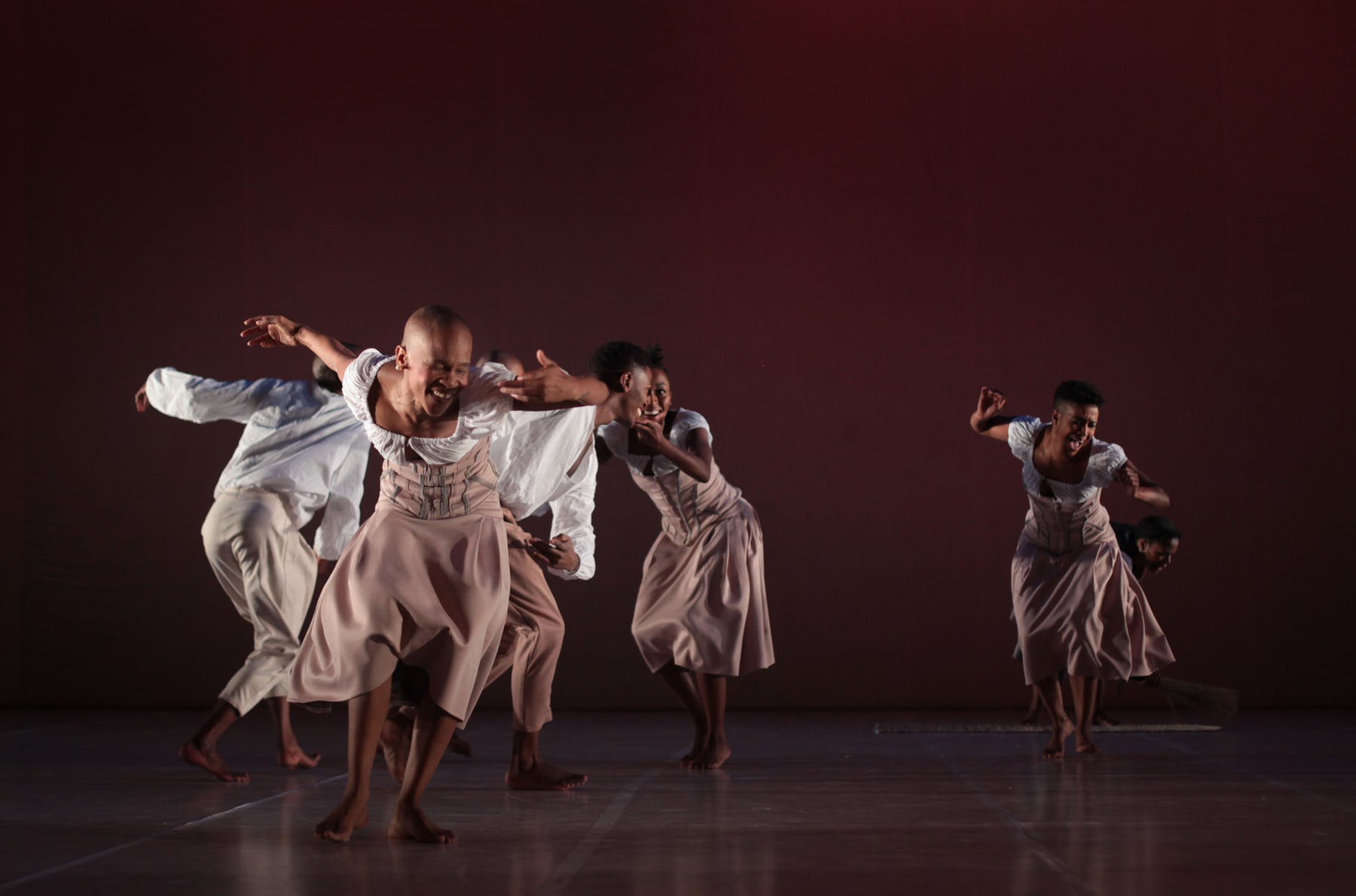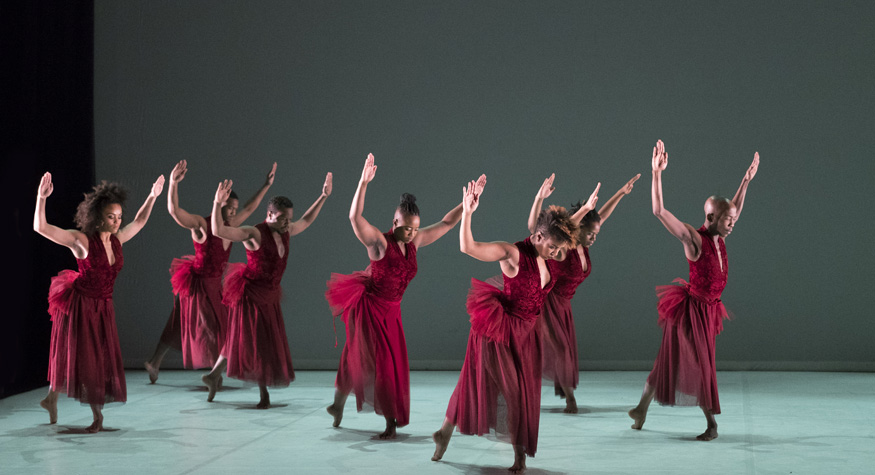The premise of Dada Masilo’s Giselle re-work (at The Lowry) is one of assigning the cultural relevance of her South African upbringing and the modern day. Giselle is still a young girl, The Wilis still a spiritual tribe who are bloodthirsty for revenge and the leader of The Wilis is a Sangoma – a South African healer. In this sense, the spiritualism and superstitions of the story are fitting to rural South African cultures. The performance of The Wilis by both men and women brings relevance to topical debates around gender fluidity. Amongst the creative re-workings, there are still the hallmarks of classical ballet with chorus lines, court dances, soloists and romantic pas de deux- but blended into a new format that avoids the rigidity of a classical production.

In the opening, we are introduced to the various characters – to Giselle, Giselle’s mother and Albrecht as they live amongst the villagers. Costumes distinguish rank, with the villagers dressed in white and beige dresses, shirts and trousers, whilst Albrecht and Bathilde are defined in black embellished costume. Masilo portrays the naivety of Giselle, falling in love for the first time, whilst her Mother tries to marry her to Hilarion. Meanwhile Giselle and Albrecht meet secretly, dancing romantic and flirtatious duets. Masilo’s choreography goes beyond the limitations of story-telling in a typical ballet – inserting speech, laughter, jokes. Giselle’s mother, performed by Sinazo Bokolo, adopts a role which is at times closer to a pantomime dame – performing soliloquies with a bottle of beer in hand.
In two parts of the first act, Giselle is stripped to her bare chest. First by her Mother, who is ‘readying’ her to court and later in cruelty, as Albrecht’s scheme is exposed, she is shamed publicly by the villagers and stripped of her clothes. The use of nudity is brave and uncomfortable – used as a way to shame, to force a young girl to ‘prepare’ for a marriage being imposed on her. With bare chest, Giselle continues her frantic, high-speed movement, trying to cover her chest and hide away – and this image next to a full-cast formally dressed made me feel intrusive for watching. It highlights the cultural differences between the West and rural South Africa, where enforced marriages, and the limited freedoms of women is still very much a normality.

Masilo’s imagery is visually powerful and evocative through minimal staging. The full ensemble moving slowly in two lines, horizontal across the stage, with humped backs in mourning at the death of Giselle. The chorus line of The Wilis, wearing deep red dresses, repeating accentuated walks with cactus-arms. The peasants gathered in a loose and carefree huddle as they share a native dance and cheer. The poeticism of the final image as Giselle throws chalk into the air and steps over the body of Albrecht, which carries the symbolism of her spirit being freed. The work evokes powerful emotions and the reality of a community – all adding to the depth of the story-telling.
Masilo has spoken in interview about the way she continues to challenge herself to take on new movement styles and something unique to her work is the blend of styles, ranging from classical ballet, contemporary, traditional African dance to physical theatre. This aids the characterisation of her work – enabling roles to be distinguished by movement language and allows limitations on expression to be removed. Masilo’s own movement is characterised by sharp, fast-twitch movements, that scuttle across the floor a little like a sped-up cartoon. With her tiny frame and bald head, her presence is at once striking and delicate.
Other outstanding performances were given by Llewellyn Mnguni as Myrtha, Queen of the Wilis. Conveying a powerful and mystical energy; commanding space as he extends his long limbs. A combination of the striking androgynous appearance – long golden hair and red dress, with masculine body – and animalistic movement quality, gives him an ethereal quality. His limbs, embodiment and characterisation are enigmatic. The Duke and Duchess’ ceremonial duet also brings yet another layer to the piece. Impressive suspended turns and strongly hit balletic extensions gives their duet elaboracy and pomp.

Whilst elements of the story remain set in a patriarchal age. Masilo brings aspects of her version en pointe with the current gender climate. The Wilis are performed by male and female dancers, all wearing the same deep-red dresses. Their movement a combination of fierce, masculine energy with elegant, balletic shapes. She thus brings a gender fluidity to the story.
One element I was a little uneasy with was the casting of Albrecht as the only white performer. Albrecht’s character already being a figure of deceit and power, it felt impossible to separate this from racial connotations. Whilst this may have significance to Masilo’s cultural background, growing up in a country scarred by racial imbalance, I felt that it was unnecessary, or at least not fully explored as a theme of the work.
Overall, Masilo’s Giselle is a powerful and passionate re-imagining of the classic ballet. Its weaving of classical and African dance movement adds ferocity and fire to an otherwise soft and sad story, it re-works the narrative into one of South African spiritualism, community and culture. Masilo herself, as choreographer and performer, is not only ingenious as a creator but also astounding as Giselle. Alongside a full cast of passionate, technically proficient performers, it was mesmerising, funny and beautiful, with very little to fault.
Reviewed at The Lowry on 22 October.


